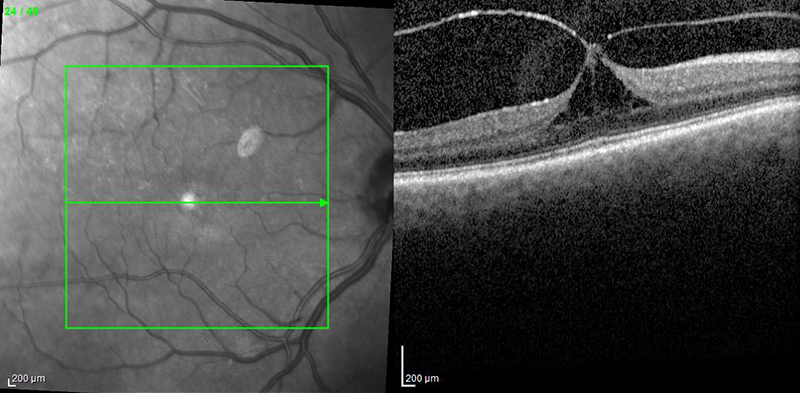Vitreomacular Traction Syndrome
 OCT of vitreomacular traction syndrome
OCT of vitreomacular traction syndrome
What is Vitreomacular Traction Syndrome?
The macula is a special area located at the center of the retina. It is responsible for clear, detailed vision. In a healthy individual, the macula normally lies flat against the back of the eye. The vitreous is the clear gel-like substance that fills the interior of the eye. As the vitreous naturally ages, it shrinks and pulls away from the retina. In some, people the vitreous can remain partially stuck to the macula, ultimately pulling on the surface of the macula and distorting the normal anatomy resulting in vitreomacular traction.
What are the symptoms of Vitreomacular Traction Syndrome?
The condition is mild in most cases with very few symptoms. Since the macula is responsible for fine vision, blurriness is the most common symptom. Since the macula is pulled on, it can begin to swell and in some cases a hole can develop there. If a macular hole develops, a small blind spot may develop in the center of the vision. In general, people do not go blind from vitreomacular traction. Even in the most severe cases, typically the peripheral (side) vision is almost always preserved.
How is Vitreomacular Traction Syndrome diagnosed?
Your retina specialist can often detect vitreomacular traction syndrome by examining your retina using a dilated eye exam. More extensive and specialized tests such as an optical coherence tomography (OCT) and fluorescein angiogram may also offer further insight. The OCT is used to document the severity of the vitreomacular traction, and a fluorescein angiogram is useful in assessing any damage to the surrounding blood vessels.
How is Vitreomacular Traction Syndrome treated?
Treatment is not necessary if symptoms are mild. However, when vitreomacular traction causes visual loss or the symptoms start to interfere with normal daily activities, then surgery is recommended. In most cases, vitrectomy surgery is the most effective treatment to release the vitreomacular traction. Additionally, in very select patients, an injection of a gas or medication in the eye may cause the vitreomacular traction to release without the need for surgery.
What is the long-term impact of Vitreomacular Traction on my vision?
How much vision is restored after surgery for vitreomacular traction generally depends on its severity and how long it was present before surgery. However, most patients note less distortion over time. Patients generally have very good anatomical outcome and improved vision after surgery.